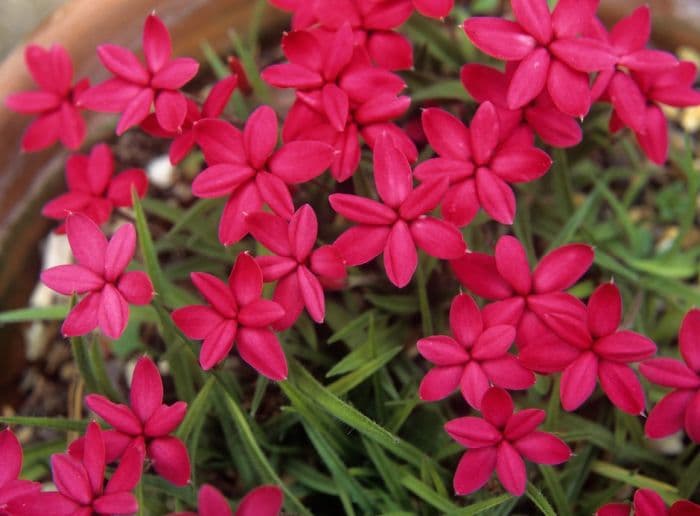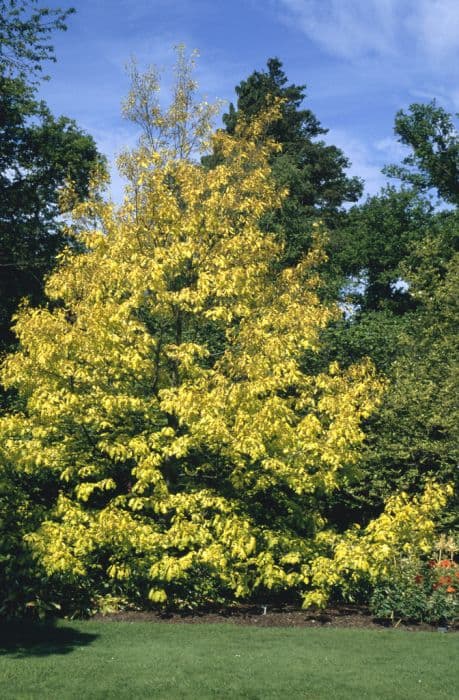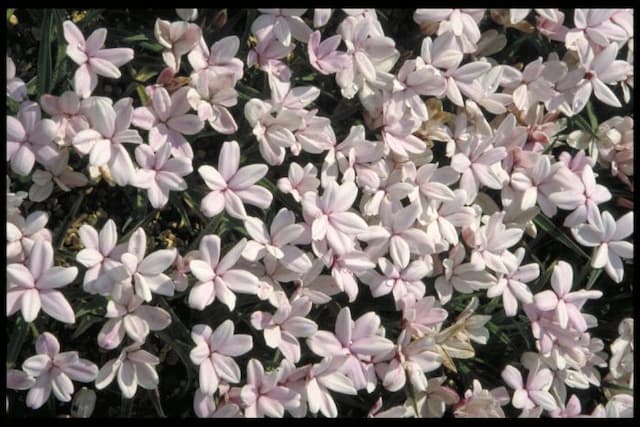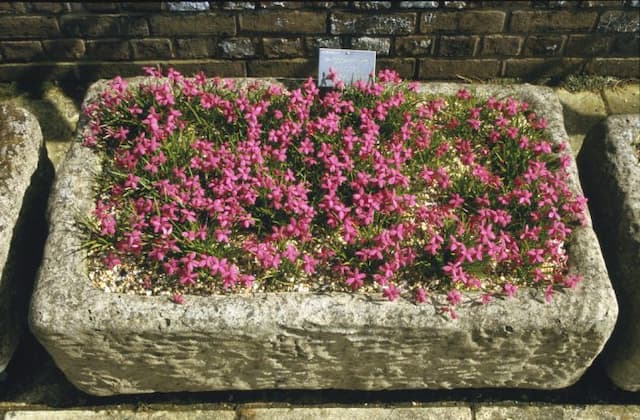Red Star Rhodohypoxis baurii 'Albrighton'

ABOUT
Rhodohypoxis baurii 'Albrighton', commonly known as the Rhodohypoxis or Red Star, is a charming perennial plant prized for its delightful display of flowers and lush foliage. The plant showcases a vibrant array of blooms that are typically a bright, rosy-pink color, each with a star-like shape which gives the common name Red Star its relevance. These blooms have petals that are arranged in a radial pattern, resulting in a symmetrical and eye-catching floral display. The foliage of the Rhodohypoxis 'Albrighton' is equally attractive, made up of narrow, grass-like leaves. These leaves form a dense clump, appearing in a rich green hue that provides the perfect backdrop for the flowers. The contrast between the green of the leaves and the pink of the flowers creates a pleasing aesthetic that can brighten up any garden space. The Rhodohypoxis 'Albrighton' plant has a clumping habit, meaning it grows in tight clusters that help it to form an effective groundcover. This habit also makes it an excellent choice for rock gardens, borders, or as an ornamental feature in a container. Its showy blooms and neat foliage make the Red Star a popular choice for gardeners looking to add a splash of color to their outdoor spaces.
About this plant
 Names
NamesSynonyms
Red Star, Albrighton Rhodohypoxis.
Common names
Rhodohypoxis baurii 'Albrighton'.
 Toxicity
ToxicityTo humans
Red star is not known to be toxic to humans. There are no well-documented adverse effects or symptoms of poisoning associated with ingestion of this plant. However, as with any non-food plant, it is generally recommended not to consume any part of it.
To pets
Red star is not known to be toxic to pets. It is not recognized by the ASPCA or other animal poison control resources as a plant that typically causes adverse symptoms if ingested by animals such as dogs or cats. However, it is still prudent to prevent pets from eating non-food plants as a general safety precaution.
 Characteristics
CharacteristicsLife cycle
Perennials
Foliage type
Deciduous
Color of leaves
Green
Flower color
Pink
Height
0 feet 4 inches (10 cm)
Spread
0 feet 4 inches (10 cm)
Plant type
Bulb
Hardiness zones
5
Native area
South Africa
Benefits
 General Benefits
General Benefits- Attracts Pollinators: Rhodohypoxis baurii 'Albrighton', commonly known as Red Star, attracts bees and butterflies, aiding in pollination.
- Low Maintenance: This plant is known for being easy to care for, requiring minimal upkeep once established.
- Ground Cover: Red Star can serve as an effective ground cover, controlling erosion and suppressing weeds.
- Drought Tolerance: It has the ability to withstand periods of low water availability, making it suitable for xeriscaping.
- Seasonal Interest: With its vibrant blooms, it adds color and visual interest to gardens during its flowering season.
- Compact Size: Its small stature makes it ideal for rock gardens, containers, and spaces with limited room.
- Hardy Nature: It is resilient in face of various outdoor conditions, with some cold and frost tolerance.
- Edging Plants: Due to its neat growth habit, it is excellent for edging borders and paths.
 Medical Properties
Medical PropertiesThis plant is not used for medical purposes.
 Air-purifying Qualities
Air-purifying QualitiesThis plant is not specifically known for air purifying qualities.
 Other Uses
Other Uses- Photography subjects: Rhodohypoxis baurii 'Albrighton', commonly known as Red Star, is often used as a charming subject in macro and garden photography, its distinct bright colors make it a visually appealing choice.
- Fairy gardens: Due to their small size and bright flowers, Red Star is commonly included in fairy garden designs, offering a vibrant touch of realism to these whimsical miniature landscapes.
- Event decorations: As a compact and colorful plant, Red Stars can be utilized as table centerpieces or decorative elements in various events like weddings or garden parties, enhancing the aesthetics with their cheerful blooms.
- Educational tools: In schools or educational workshops, Red Stars can serve as an example for teaching about bulbous plants and their growth cycles to students and gardening beginners.
- Artistic inspiration: Artists may use the vibrant Red Star flowers as live models for paintings, drawings, and other artwork, capturing the beauty of these blooms on the canvas.
- Culinary decoration: Although not edible, the flowers can be used temporarily to garnish dishes during plating for culinary photography, contributing an extra pop of color before serving.
- Seed saving: Red Stars can be cultivated by garden enthusiasts who practice seed saving, allowing the propagation of this specific variety for future planting seasons.
- Bee and butterfly gardens: The flowers of Red Star attract pollinators such as bees and butterflies, making them suitable for inclusion in gardens designed to support these insects.
- Mood enhancement: The bright and cheerful appearance of Red Star can be harnessed in therapeutic settings like spas or retreat centers to create a calming and uplifting environment.
- Hobbyist collecting: Red Stars can be a part of specialized plant collections for hobbyists who focus on collecting different Rhodohypoxis varieties or alpine plants.
Interesting Facts
 Feng Shui
Feng ShuiThe Rhodohypoxis is not used in Feng Shui practice.
 Zodiac Sign Compitability
Zodiac Sign CompitabilityThe Rhodohypoxis is not used in astrology practice.
 Plant Symbolism
Plant Symbolism- Determination: Rhodohypoxis baurii 'Albrighton', commonly known as Rhodohypoxis or Red Star, though possessing a delicate appearance, is a hardy plant that can withstand various environmental challenges, hence symbolizing determination.
- Resilience: This plant is capable of bouncing back from harsh winter conditions to bloom brightly in spring and summer, representing resilience in the face of adversity.
- Beauty and Grace: With its star-shaped flowers and graceful foliage, Rhodohypoxis embodies beauty and the elegance of simplicity.
- Vitality: The vibrant colors of Rhodohypoxis flowers suggest a symbol of vitality and the joys of life.
 Water
WaterRhodohypoxis baurii, commonly known as Red Star, requires moderate watering during its growing season in spring and summer, around three times a week, depending on the weather conditions. It's crucial to let the soil dry out slightly between waterings, and then thoroughly soak it, using approximately one to two gallons per week for an outdoor plant in a moderate climate. During the dormant period in autumn and winter, reduce watering to a minimum, only ensuring the soil does not completely dry out. Overwatering, especially in winter, can cause bulb rot, so it’s better to err on the side of underwatering.
 Light
LightRed Star prefers bright, indirect light or partial shade. Too much direct sunlight can scorch the leaves, whereas too little light can reduce flowering. The best spot for this plant would be in an east or south-facing garden where it receives morning sunlight and is protected from the harsh afternoon sun. If grown indoors, a window with a sheer curtain can provide the ideal light conditions.
 Temperature
TemperatureRed Star thrives in temperatures ranging from 50°F to 70°F, making it ideal for growth in moderate climates. It can survive temperatures down to about 40°F, but frost can be harmful, so it's best to protect it during cold snaps. The ideal temperature conditions to promote blooming would be on the warmer side of its range, around 60°F to 70°F.
 Pruning
PruningPruning the Red Star is not typically required, as the plant has a naturally compact growth habit. However, after flowering, you can deadhead the spent flowers to promote further blooming and maintain the plant's appearance. Pruning to remove any dead or damaged leaves can be done as needed to keep the plant healthy, but major pruning is generally not necessary.
 Cleaning
CleaningAs needed
 Soil
SoilThe Red Star requires a well-draining, sandy soil mix with a pH of slightly acidic to neutral (pH 5.5-7). A mixture containing equal parts of loam, sand, and peat moss would create an ideal environment for this plant. Proper drainage is essential to prevent root rot, so incorporating perlite or grit into the mix can further help with aeration and water management.
 Repotting
RepottingRed Stars should be repotted every 2 to 3 years, or when they outgrow their pots. Repotting is best done in late winter or early spring before new growth begins, as this is when the plant is coming out of dormancy and can recover more easily from any disturbance.
 Humidity & Misting
Humidity & MistingRed Stars prefer moderate humidity levels around 50-60%. They can tolerate lower humidity environments but may not thrive as they naturally occur in areas with higher humidity. Avoid placing them in extremely dry or drafty areas.
 Suitable locations
Suitable locationsIndoor
Place Red Star in bright, indirect light and avoid overwatering.
Outdoor
Plant Red Star in partial sun, protect from harsh elements.
Hardiness zone
7-9 USDA
 Life cycle
Life cycleRhodohypoxis baurii 'Albrighton', commonly known as the Rhodohypoxis or Red Star, begins its life cycle as a dormant bulb during winter. As temperatures rise in spring, it breaks dormancy with the emergence of grass-like leaves and followed by star-shaped flowers that can be pink, red, or white. Throughout the summer, the plant continues to grow and multiply, forming clumps as the bulbs divide. After flowering, which typically occurs from late spring to summer, the plant begins to die back as the season transitions to autumn. During this period, the foliage yellows and withers, signaling the beginning of the plant's dormancy again. The cycle repeats yearly as each bulb can survive for several years, with new bulbs forming alongside the original as part of its reproductive process.
 Propogation
PropogationPropogation time
Spring
Propogation: Rhodohypoxis baurii 'Albrighton', commonly known as Red Star, is typically propagated through division. This is most effectively done in early spring as the plant emerges from dormancy. To propagate by division, carefully lift the clump of plants from the ground and gently separate the corms, ensuring that each section has at least one growth point. Replant the divisions immediately at the same depth they were originally growing, spaced about 3 inches (approximately 7.6 centimeters) apart to allow for adequate room for growth. Water the newly planted divisions thoroughly to establish them. This method allows gardeners to quickly expand their collection of Red Star and ensures that the new plants will bear the same characteristics as the parent.
![Rhodoxis [Fairytale]](/_next/image?url=https%3A%2F%2Fplants-admin.emdemapps.com%2Fimages%2Fplants%2F%2Fimages%2F604b54204420d.png&w=640&q=75)



